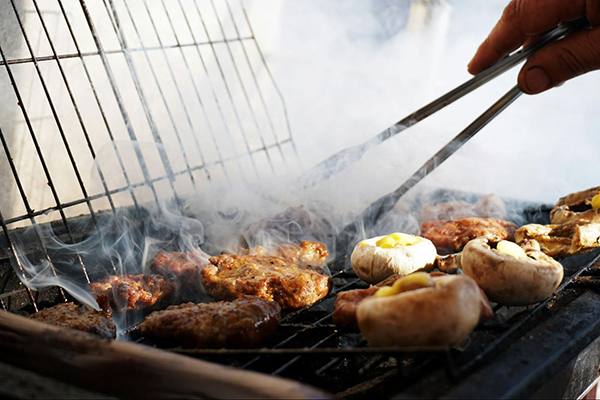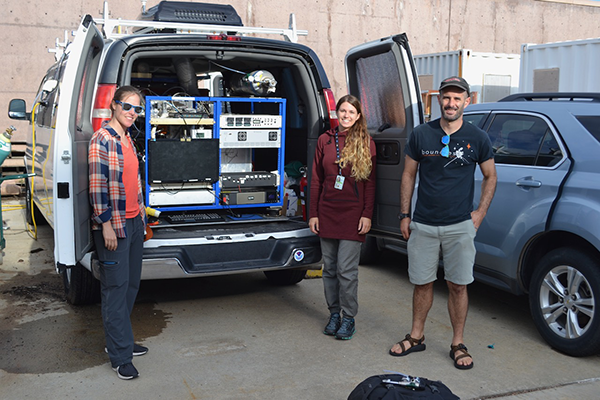2024 News & Events
That Delicious Smell May Be Impacting Air Quality
6 May 2024

A new study finds that air pollutants emitted from food cooking can account for nearly a quarter of human-caused volatile organic compounds (VOCs) in dense urban areas.
Stroll along the downtown streets of any major city around dinner time and it's easy to identify the mouth-watering aromas of cooking foods – the enticing smells attracting hungry patrons to nearby restaurants like moths to a flame.
But if there's one thing the scientists at NOAA CSL have learned in their years-long deep dive investigating the unrecognized and underappreciated sources of urban air pollution, it's this: if you can smell it, there's a good chance it can impact air quality.
When it comes to those delicious food smells, the impact could be significant, according to a new study published in the journal Atmospheric Chemistry & Physics quantifying cooking emissions in the urban air of downtown Las Vegas.
"The types of emissions we are looking at from cooking, primarily oxygenated VOCs, or volatile organic compounds, are quite reactive in the air, so we expect they'll be important for air quality," explained Matt Coggon, a research chemist at CSL and lead author of the study.
Coggon and his team determined that on average, 21% of the total mass of human-caused VOCs present in Las Vegas' outdoor air were from cooking activities. Depending on the time of day, cooking VOCs ranged from from 10% to 30% of the total.
That cooking emissions can account for nearly a quarter of the urban VOCs was unexpected, particularly given that the U.S. National Emissions Inventory (NEI) has estimated this source at an insignificant 1%. On an absolute basis, the NEI underestimates cooking emissions by a factor of 5–10.
In Coggon's estimation, this makes cooking emissions the single largest missing source of urban VOCs in current air quality models, and that could imply important ramifications for regulatory policy.
CSL and CIRES researchers have devoted the better part of 10 years towards identifying, quantifying, and inventorying the myriad VOCs in urban air that degrade air quality. VOCs are extremely important for urban air quality as they lead to the production of both ground-level ozone pollution and particulate matter (PM2.5).
These efforts have included pioneering research on volatile chemical products (VCPs), a previously unrecognized class of VOCs produced from consumer products such as personal care products, fragrances, paints, and adhesives, that can comprise around 25–50% or more of the total human-caused VOC emissions in urban areas.
"Over the years we've measured all sorts of different VOCs across the U.S. from different sources, like vehicles, wildfire smoke, agriculture, and consumer products," explained Coggon. "We kept seeing a specific class of compound in the urban measurements, what we call long-chain aldehydes, that we couldn't explain from these other sources."
These long-chain aldehydes, including octanal and nonanal (which have 8 carbons and 9 carbons, respectively), were particularly elevated in the air around downtown urban centers. Previous reports on indoor air quality in homes had identified these aldehydes as a major component of cooking emissions, arising from the thermal breakdown of oils and fats. Other researchers have also begun to adopt these aldehydes as unique markers for restaurant emissions.
So the researchers turned their focus to the invisible, but often odorous, VOCs that are emitted when grilling, sautéing, searing, or otherwise cooking meats and vegetables.


In the summer of 2021, Coggon and his colleagues in Boulder outfitted CSL's mobile laboratory with specialized instrumentation capable of identifying and measuring hundreds of different airborne VOCs and headed west to Las Vegas to find out just how important cooking emissions might be for urban air quality.
Home to one of the highest restaurant densities in the United States – a whopping 666 restaurants per 100,000 people – Las Vegas has been described as a "devilishly" food-obsessed city. Las Vegas also happens to have persistent air quality concerns, with significant impacts from local pollution from the Las Vegas Strip – a high-traffic entertainment district with a high density of casinos, hotels, bars, and restaurants.
For several weeks in June and July, the researchers drove their mobile laboratory around Las Vegas and the surrounding desert to map the air quality across residential, commercial, and entertainment districts. Particular focus was given to the Las Vegas Strip, cruising up and down the avenue at different times of the day from noon to 2 am.
Although Las Vegas is a sprawling city, the spatial mapping revealed that octanal and nonanal emissions were mostly concentrated along the Strip, roughly correlated with the density of nearby restaurants, and at highest levels during the evening hours when dining and other entertainment activities peaked.
Octanal and nonanal represent a significant fraction of the VOCs produced from cooking, but are still just two of many, with a wide variety of other aldehydes, ketones, monoterpenes, and fatty acids also emitted. To estimate the total footprint of cooking emissions, a source apportionment analysis was used to assign all of the different VOC compounds they measured to specific source types (e.g, cooking, vehicle traffic, VCPs) based upon correlations with known markers for each source – in this case, nonanal was used as the marker for cooking.
For downtown Las Vegas, they determined that 50% of the human-caused VOC emissions were from VCPs, and the remaining half was split nearly equally between cooking emissions and vehicle traffic.
"It was surprising even to us that emissions from food cooking can be on par with vehicle traffic when it comes to VOCs," recalled Coggon.
The team cautions that the particularly high density of restaurants in Las Vegas may mean that these measurements represent an upper limit on how much cooking matters for air quality in the U.S. Even so, research in other cities is providing early indications that cooking emissions may be a big, unsolved piece of the air quality puzzle in major cities worldwide.
Although the researchers know that the kinds of VOCs emitted from cooking are reactive, just how much ozone or PM2.5 production may be attributed to these cooking emissions is still an unanswered question – one that this group of researchers is already tackling with their now more complete and accurate VOC inventory and air quality model.
They hope that this new information will be valuable to cities such as Las Vegas that are working to address air quality concerns. When it comes to considering policy options, Coggon stressed that "it's crucial to have the full picture of pollutant emissions and sources" so that we can understand the full effect that different decisions might have.
Coggon, M.M., C.E. Stockwell, L. Xu, J.B. Gilman, A. Lamplugh, J. Peischl, H. Bowman, K. Aikin, C. Harkins, Q. Zhu, R. Schwantes, J. He, M. Li, K. Seltzer, B. McDonald, and C. Warneke, Contribution of cooking emissions to the urban volatile organic compounds in Las Vegas, NV, Atmospheric Chemistry and Physics, doi:10.5194/acp-24-4289-2024, 2024.
Abstract
Cooking is a source of volatile organic compounds (VOCs), which degrade air quality. Cooking VOCs have been investigated in laboratory and indoor studies, but the contribution of cooking to the spatial and temporal variability in urban VOCs is uncertain. In this study, a proton-transfer-reaction time-of-flight mass spectrometer (PTR-ToF-MS) is used to identify and quantify cooking emission in Las Vegas, NV, with supplemental data from Los Angeles, CA, and Boulder, CO. Mobile laboratory data show that long-chain aldehydes, such as octanal and nonanal, are significantly enhanced in restaurant plumes and regionally enhanced in areas of Las Vegas with high restaurant densities. Correlation analyses show that long-chain fatty acids are also associated with cooking emissions and that the relative VOC enhancements observed in regions with dense restaurant activity are very similar to the distribution of VOCs observed in laboratory cooking studies. Positive matrix factorization (PMF) is used to quantify cooking emissions from ground site measurements and to compare the magnitude of cooking with other important urban sources, such as volatile chemical products and fossil fuel emissions. PMF shows that cooking may account for as much as 20 % of the total anthropogenic VOC emissions observed by PTR-ToF-MS. In contrast, emissions estimated from county-level inventories report that cooking accounts for less than 1% of urban VOCs. Current emissions inventories do not fully account for the emission rates of long-chain aldehydes reported here; thus, further work is likely needed to improve model representations of important aldehyde sources, such as commercial and residential cooking.